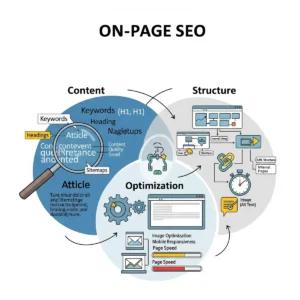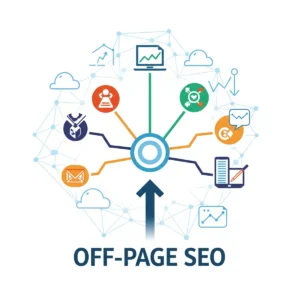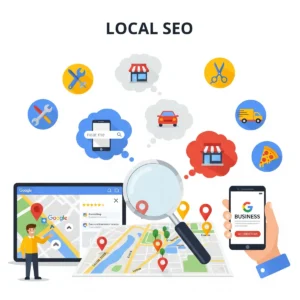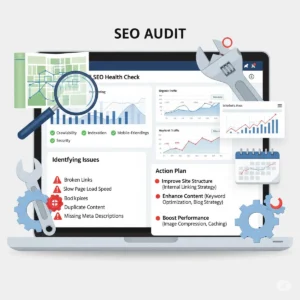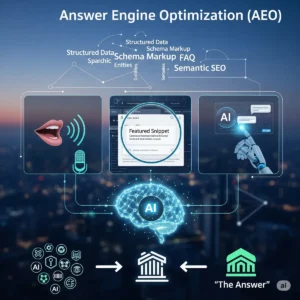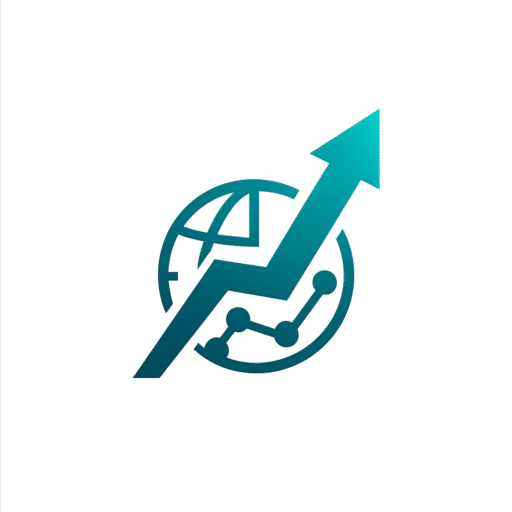What Is Search Engine Positioning?
In my years of working with SEO, I’ve seen how search engine positioning often gets overlooked, even though it’s about fine-tuning how specific pages of a website perform.
Unlike broad SEO strategies, this focuses on optimizing a product page or even blog posts that are already performing but not yet landing on the top results of a SERP. The technique is to continually optimize so that you increase rankings and visibility, because showing up in organic result number three on Google is very different from showing up first.
A recent study by Sage Agency showed that moving even a few positions can drastically impact:
- Traffic
- Conversions
- Click-through rate (CTR)
I’ve noticed this firsthand: when a client’s FAQ page slipped into the people also ask boxes, their impressions shot up instantly. Later, when a guide won featured snippets, the impact was huge.
Don’t forget the different features like image results, which sometimes outperform traditional links depending on the query. To apply this approach means thinking not just about visibility, but about owning every placement that influences how users interact with your page before they click-through.
Search Engine Positioning Vs. SEO
| Terms | Search Engine Positioning (SEP) | Search Engine Optimization (SEO) |
| Search / Engine / Positioning | Focuses on adjusting search engine positioning of individual webpages to climb higher in rankings. | Broader search engine optimization (SEO) approach covering all aspects of a website. |
| Techniques | Specific techniques for improving rankings on Google like targeting a static page to push it higher. | Wider techniques such as keyword research, link building, technical fixes, and page speed improvements. |
| Impact | Direct impact on visibility for certain keywords in results and SERPs. | Long-term impact on entire site traffic, competitors, and rankings. |
| Broader Concept | Not a broader concept—it’s narrow and page-focused. | A broader concept involving everything from crawlability to algorithm updates. |
| Local Business Owners | Helps local business owners gain visibility for specific keywords. | Essential for local and global businesses to stay competitive. |
| Ongoing Process | Not always an ongoing process—you monitor changes and push pages when needed. | An ongoing process of working to improve visibility, adapting to algorithm updates, and fighting competitors. |
| Results | Short-term results by boosting one or two pages. | Long-term results that reduce risks and sustain traffic growth. |
Why is search engine positioning important?
When you apply search engine positioning to grow your rankings, you can expect the following benefits:
Maximize organic search traffic
When you focus on how to maximize organic search traffic, the real benefits show up in how your website performs. I’ve seen even a small uptick on a few pages turn into measurable conversions and more sales, especially when the marketing team and content creators align.
Key ways I’ve made this work:
- Publish consistent content that actually answers user intent.
- Optimize existing pages to capture a growing audience.
- Track conversions closely to measure impact and increase ROI.
In practice, I’ve noticed that when both SEO specialists and the sales and marketing team collaborate, the results compound. A single well-optimized article can increase not just traffic, but the flow of qualified leads that matter.
Increase brand awareness
One of the fastest ways to increase brand awareness is by creating solutions people actually want—like when I once helped promote a photo editing software that was developed to be the best free app in its niche. The strategy was simple: spread the word, attract users, and push it toward a higher ranking on the top SERP results.
According to Ahrefs data, targeting keyword phrases with high monthly searches in the US can significantly improve visibility.
Tactics I’ve seen work well:
- Position content to achieve top SERP spots.
- Highlight features of a free app that users genuinely value.
- Monitor ranking progress and refine content to keep climbing.
With the right focus, a product can move from being unknown to a go-to choice, driving awareness while steadily building trust.
Get ahead of your competitors
To get ahead of your competitors, you need to understand how your industry rivals compete for keywords and what makes the difference in visibility. From my experience, being on the first page of results doesn’t just mean presence—it means higher CTR and more traffic generated than those sitting on a lower rank.
I once worked with a photo editor tool that had to compete with big names. By moving into top positions for high monthly search terms, it started outperforming the average players who received far less traffic.
Key takeaways:
- Always track positions on the first page to spot gaps.
- Push content where CTR is high to maximize impact.
- Remember: those who receive steady visibility consistently stay ahead.
When you align strategy with keyword intent, it becomes much easier to not just match rivals but to consistently outperform them.

How To Do a Search Engine Position Analysis
How To Do a Search Engine Position Analysis
When I run a search engine position analysis, the first step is always picking the right tool. Personally, I rely on Ahrefs Site Explorer because it answers the questions that matter: which individual webpages have improved, and which have decreased in rankings over the past few months.
Detailed Tips:
- Run a Domain Report
- In Ahrefs Site Explorer, open the organic keywords report for your domain.
- This report shows which keywords your site ranks for by default and how each position column has changed.
- In Ahrefs Site Explorer, open the organic keywords report for your domain.
- Compare Current vs. Prior Periods
- Use the filter to select a period of choice (e.g., last 3 months).
- This compares your current rankings with the prior set, highlighting gains or losses in positions.
- Use the filter to select a period of choice (e.g., last 3 months).
- Prioritize Strategy Based on Data
- Look at data for pages that slipped from the top results down to the second or third page.
- These are strong re-optimization candidates, since they’ve already shown ranking potential.
- Look at data for pages that slipped from the top results down to the second or third page.
- Analyze Ranking Questions & Answers
- Check if your content appears in questions and answers boxes.
- If visibility decreased, you may need to modify content to reclaim those spots.
- Check if your content appears in questions and answers boxes.
- Decide What to Re-Optimize
- Focus on webpages with declining results that still bring meaningful traffic.
- Adjust strategy by updating or improving content to make it more relevant.
- Focus on webpages with declining results that still bring meaningful traffic.
By following this flow, you don’t just look at numbers—you uncover position shifts that directly affect visibility, and you know exactly which content pieces to update to regain or grow rankings.

How To Improve Search Engine Positioning
Trying to improve search engine positioning can feel frustrating, especially when you’ve already invested so much time and resources. I’ve learned that the key is consistently creating high-quality content that actually connects with your target audience.
Tips I’ve found effective:
- Focus on content that has real impact rather than just volume.
- Aim to reach the top SERP positions with topics your audience cares about.
- Balance SEO best practices with natural storytelling to build trust.
Over the years, I’ve seen that the websites winning aren’t always the biggest—they’re the ones that stay consistent, keep refining, and never stop publishing valuable material.
Meet Search Intent
To truly meet search intent, you need to understand the reason behind every user query. On Google’s engine, there are different types of intent:
- Informational → users want to learn about a topic (e.g., “Instagram help center”).
- Navigational → they’re looking for a specific page.
- Commercial research → comparing a product, like “commuter bikes.”
- Transactional → ready to purchase or buy.
I’ve found analyzing top-ranking results with Ahrefs Keywords Explorer gives a clear overview and breakdown of intents. By identifying mismatches and reoptimizing content, you can position your pages higher in rankings, boost traffic, and give users exactly what they expect.

Optimize for SERP Features
To optimize for SERP features, go beyond traditional results and plain links. Modern SEO means shaping your webpage so it can appear in:
- Featured snippets
- Knowledge panels
- Image packs
- Videos
- People also ask boxes
When I target these, I format content with paragraphs, lists, or tables for quick explanations. Writing short, clear sentences and creating a practical guide has consistently boosted positioning, reach, and traffic for my clients.
Add Secondary Keywords
Don’t just focus on one keyword—always add secondary keywords. Think long-tail variations, synonyms, and other relevant queries. These send a strong signal to engines and users that your content covers the topic in detail.
Using Ahrefs Explorer, I often pull ideas, questions, and suggestions, then apply filters to find the lowest keyword difficulty with suitable DR levels. The key is to incorporate these naturally into the text, making sure not to overuse them.

Use Internal Links to Boost Your Pages
A simple but powerful way to use internal links is to boost pages with more organic search traffic potential. Internal linking passes link equity and authority across your domain, similar to how PageRank works.
From my experience, the strategy is clear:
- Choose a URL that needs growth.
- Add relevant references from strong referring pages.
- Use descriptive anchor text that feels natural.
- Keep an eye on the number of internal links to avoid overloading.
When done right, internal linking is one of the easiest and most determined ways to grow traffic without needing new backlinks.
SEO Overview vs. SEM Overview
| Aspect | SEO Overview | SEM Overview |
| Definition | SEO is the practice of optimizing a website to rank in organic, non-paid search engine results pages (SERPs) on Google, Bing, and other search engines. | SEM combines SEO with PPC paid ads, where visibility is achieved by bidding on keywords to make your ad appear in Google or Bing rankings. |
| Focus | Relies on ranking signals from the algorithm, including on-page, off-page, technical, and user interaction factors. | Relies on bidder activity, ad groups, management, and budget spend to gain clicks at a defined cost per click (CPC). |
| On-Page Factors | Optimizing title tags, meta descriptions, URLs, and keywords to match customer query intent. | Optimizing landing page copy, ensuring strong quality score metrics, and lowering CPC with relevant keywords. |
| Off-Page Factors | Building trust, authority, and backlinks through E-E-A-T, social media sharing, and interlinking for higher rankings. | Depends less on backlinks, more on account management, CTR, and ad discounts that come from strong quality scores. |
| Technical Elements | Ensuring a site can crawl and index properly, loads quickly, has clean site architecture, and avoids bounce, pogo-stick effect, or poor indexing. | Technical focus is lighter—mainly on landing pages that convert efficiently with optimized copy and CTR performance. |
| Interaction & Behavior | User interaction (time on page, avoiding bounce, query matching) is critical for sustaining rankings. | Interaction measured in clicks, CTR, and conversions from ads rather than organic behaviors. |
| Costs | SEO traffic is organic and doesn’t charge per click, but requires ongoing time and effort. | SEM is paid, with ongoing bidding and spend. Costs vary depending on keywords, competition, and CPC. |
Want to improve your search engine positioning? Let’s talk! Reach out today at “info@ashirdigitals.com”
FAQs About Search Engine Positioning
Q1. What is the difference between search engine and SEO?
A search engine (like Google or Bing) is a platform that delivers results for user queries, while SEO is the practice of optimizing websites so they rank higher in those search results.
Q2. What is search engine positioning?
Search engine positioning is about improving the ranking of individual pages on a SERP. Unlike broad SEO, it focuses on moving specific pages higher to increase visibility and traffic.
Q3. What are the 4 types of SEO?
The four types are:
- On-page SEO (optimizing content, titles, meta descriptions).
- Off-page SEO (building backlinks and authority).
- Technical SEO (crawlability, speed, indexing).
- Local SEO (targeting location-based searches).
Q4. What’s the difference between SEO and SMO?
SEO focuses on improving visibility in search engines, while SMO (Social Media Optimization) is about enhancing brand presence and engagement on social platforms.
Q5. What are the three types of SEO services?
Most agencies offer:
- Technical SEO services
- Content/on-page SEO services
- Link building/off-page SEO services
Q6. Are SMO and SMM the same?
No. SMO is about optimizing content for social platforms, while SMM (Social Media Marketing) involves running paid and organic campaigns to promote content and drive conversions.

